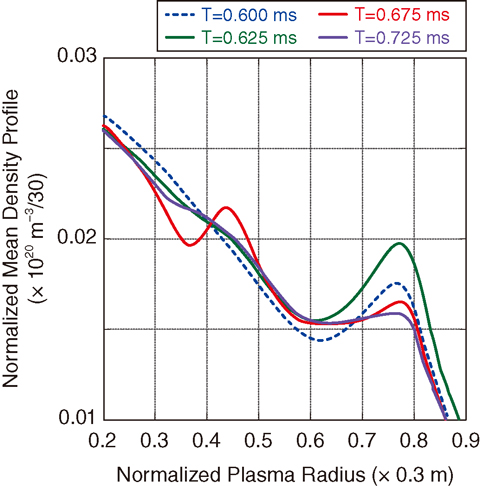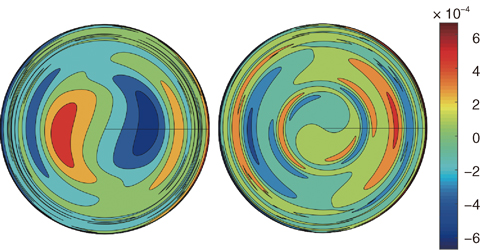
Fig.9-21 Time evolution of the mean density profile

Fig.9-22 Our plot of fluctuating density in a poloidal cross section
For the realization of a tokamak fusion reactor, it is necessary to sustain the burning state. For this purpose, real-time diagnostics with feedback to external profile control should be developed to avoid the degradation of energy confinement and disruptive plasma collapse phenomena. Various control methods have been proposed, such as current profile control through an external current drive and density profile control through pellet injection. A thorough understanding of the plasma response is an important prerequisite for plasma control. In conventional transport codes, the profile evolution was analyzed under the assumption that a steady state is instantaneously realized for all processes that are faster than the collision time. For the dynamic control of plasmas, this assumption should be relaxed.
It has recently been reported that, during pellet injection experiments in tokamaks, an abrupt increase in the electron temperature in the central region simultaneously occurs with a cooling of the plasma edge. This phenomenon occurs on a time scale that is shorter than the collision time and is thought to originate from direct interactions between the central and peripheral regions. To describe such a non-local response, a transport model has recently been proposed, wherein the flux is formulated on the basis of an integral kernel. Such a model can capture transport processes that occur on time scales faster than the collision time. However, direct interactions between the central and peripheral regions of the plasma were not considered.
In this study, the source associated with pellet injection is implemented in a 4-field reduced magnetohydrodynamics (MHD) model, and the transient plasma response is examined. Fig.9-21 shows the time evolution of the mean density profile in a case where the density source is initially applied to the plasma edge and subsequently turned off.![]() represents the density profile just after the source is turned off. It is seen that a non-local profile change appears at a location far away from the source at the moment the density abruptly decreases in the peripheral region. Since the model is normalized by the time that is characteristic for MHD instabilities, it is clear that this phenomenon occurs on a time scale that is much shorter than the collision time. To examine the response in the plasma core, two-dimensional contour plots of the fluctuating density are produced, as shown in Fig.9-22. It is found that the non-local response is accompanied by the formation of a spiral structure. Once this structure forms, it can directly connect the central region with the peripheral one. This may facilitate non-local responses. On this basis, the observed non-local response, the underlying physical mechanism of which has remained obscure so far, can now be understood as a two-dimensional transport phenomenon.
represents the density profile just after the source is turned off. It is seen that a non-local profile change appears at a location far away from the source at the moment the density abruptly decreases in the peripheral region. Since the model is normalized by the time that is characteristic for MHD instabilities, it is clear that this phenomenon occurs on a time scale that is much shorter than the collision time. To examine the response in the plasma core, two-dimensional contour plots of the fluctuating density are produced, as shown in Fig.9-22. It is found that the non-local response is accompanied by the formation of a spiral structure. Once this structure forms, it can directly connect the central region with the peripheral one. This may facilitate non-local responses. On this basis, the observed non-local response, the underlying physical mechanism of which has remained obscure so far, can now be understood as a two-dimensional transport phenomenon.
The insights obtained in this study will contribute to the establishment of a physical basis for dynamic control of the ITER and DEMO plasmas as well as non-local transport modeling.